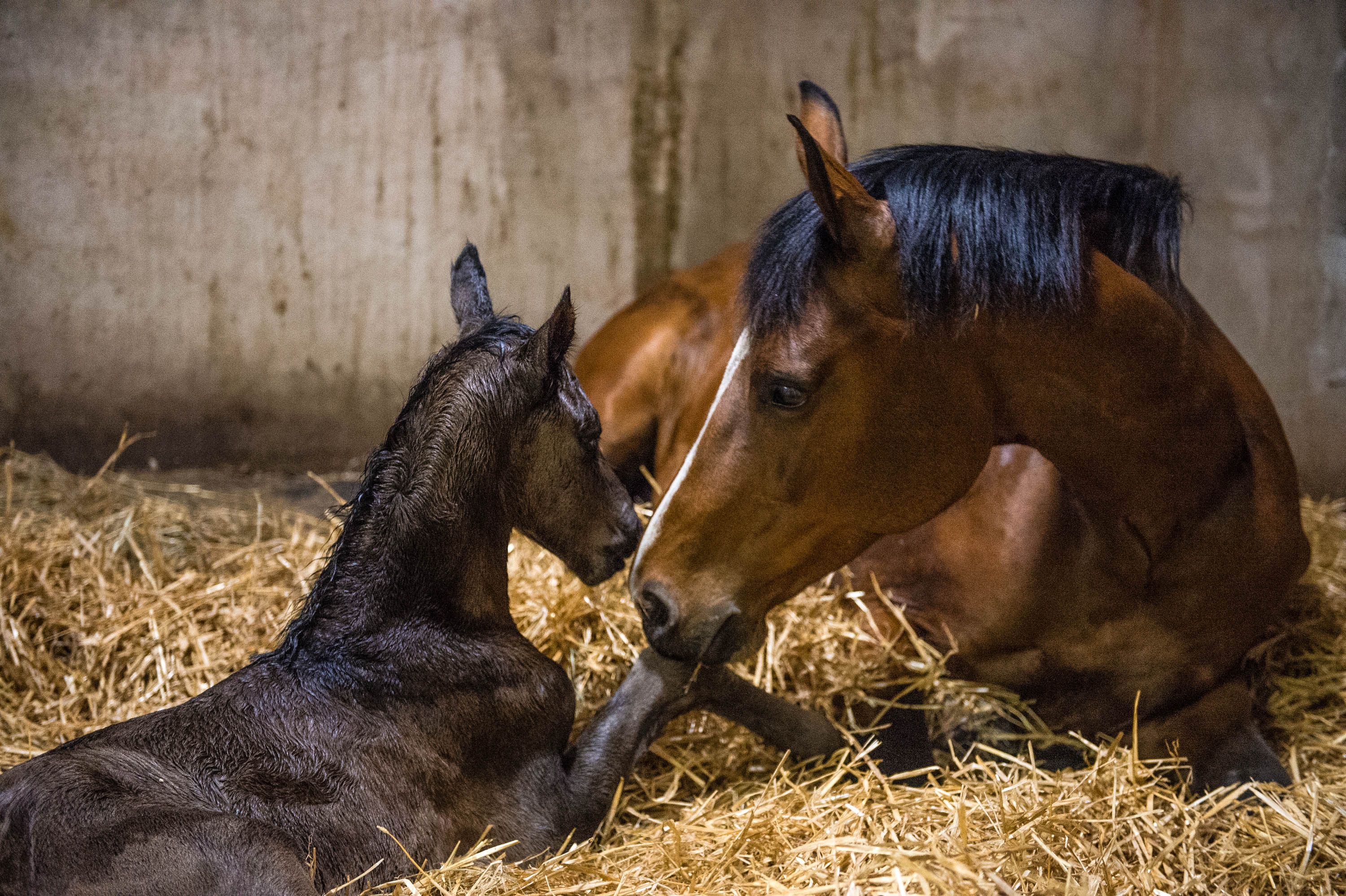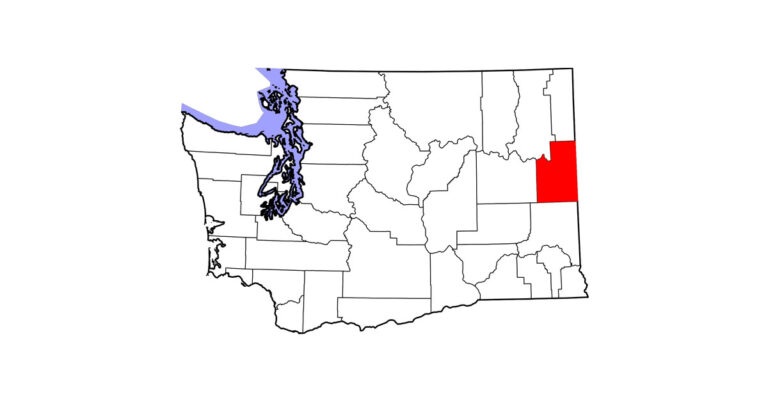It’s midmorning at Hilltop Farm, a sport-horse breeding facility in Colora, Maryland. Megan Fischer, the director of Raising Services, and her crew open a gate in the “foal weaning pasture” to let the herd of mares and foals into a paddock where piles of fresh hay are spread out on the ground. As the horses settle down to eat, Megan quickly and quietly halters the mother of the oldest foal, a 4-month-old colt and leads her to a trailer waiting beside the paddock. Her foal doesn’t even lift his head from the hay pile he’s working on with one of his buddies. He’s a confident, independent foal, but, more importantly, he’s accustomed to being separated from his mother for short periods of time.

Megan takes the mare to a far pasture out of earshot of the foal weaning field. After unloading, the mare whinnies once for her colt, then recognizes some former friends in the pasture and trots out to join them. Back in the foal weaning paddock, when the hay is gone, the mares and foals are released into the bigger pasture. The new weanling takes a quick canter around the field looking for his mother, then rejoins the rest of the herd, who are grazing quietly.
How can breaking the strong mother-foal bond be so peaceful? As Megan and Dr. Christine Skelly, associate professor of Michigan State University’s Adult Equine Extension Programs and founder and director of My Horse University, explain in this article, by taking steps to instill confidence in your foal beforehand, you can make this potentially traumatic transition smooth and painless.
Why Wean, and When?
In the wild, mares allow their foals to nurse for a year or more, not pushing them away until they give birth to their next offspring. In domestic situations, however, there are many practical reasons to wean earlier. For example, you may want to sell your foal by a certain age, or you may have riding/competition plans for your mare that can’t be achieved with the foal tagging alongside.
Another compelling reason to wean is if your mare’s body condition is rapidly deteriorating. This happens sometimes when a foal’s nutritional demands outpace the mare’s milk supply. Without adequate nutrients to sustain her own body, the mare may experience health issues, such as an inability to conceive again. A nursing mare should maintain a body condition score of 5 or 6, which, says Dr. Skelly, “means her backbone is level?not protruding out or hidden below a crease of fat?and you should be able to feel, but not see, her ribs.”
Dr. Skelly generally recommends weaning between 4 and 6 months of age. “Before four months, foals are not as adept at eating forage and grain,” she explains. It’s fine to wait longer than 6 months, she says, “but keep in mind that the bigger they get, the harder they’re going to be to handle.”
Preparing the Foal
Both Dr. Skelly and Megan recommend approaching the weaning process with the goal of minimizing stress. “The mare-foal bond is extremely strong,” says Dr. Skelly. “You’re removing everything that a foal knows: the caregiving and nutritional bond, as well as communication through all of the senses?sight, taste, touch, hearing and smell.”
The more abruptly you deprive the foal of these things, the more traumatic the experience can be. He may panic and injure himself?or the stress of weaning may suppress his immune system. Dr. Skelly says this makes a foal more vulnerable to conditions such as colds, flu, strangles and pneumonia.
To fortify your foal’s immune system, she recommends following a good health program from birth, including vaccination and deworming schedules approved by your veterinarian, as well as regular hoof trimming. Note: If you plan to castrate your colt, give him several weeks to adjust to being weaned first.
Handling your foal frequently and ?accustoming him to a routine early on will help to minimize stress levels at weaning time. At Hilltop, says Megan, “we break our program into building blocks. From birth to weaning time, we’re building the foals’ confidence, teaching them the same routines they’ll experience as yearlings, two-year-olds and three-year-olds.”
These experiences include daily grooming, picking up feet and leading alongside the mare. Once a foal is comfortable being handled, he’s led just outside the mare’s stall to be groomed. When he’s comfortable with that, he’s led to a grooming area farther away, but still in sight of his dam. Eventually, he graduates to being led away from his mother?and vice versa?long enough to have his hooves trimmed.
Megan says her program introduces ?everything to the foals step-by-step, adapting it to suit each individual. She explains, “The foals who are laid-back and willing to try whatever we ask of them need only a day with each step. Some foals worry and need more time to build confidence.”
Regular handling is a great way to get to know your foal’s temperament, which will help you anticipate how he will react to the weaning process. Megan explains, “Some foals are so confident they’re just like, ?See ya, Mom!’ Some are real ?mama’s boys’ and have a much harder time.'”
Which Method is Best?
Megan and Dr. Skelly agree that, ?although different weaning techniques work in different horse operations, more gradual methods are less stressful than abrupt separation?suddenly taking the mare completely out of sight and earshot of the foal.
One gradual method, “fence-line weaning,” eliminates nursing access while still ?allowing sensory contact. Separated by a safe fence, the mare and foal can see, smell, hear and touch each other, but the foal can’t nurse. Although Dr. Skelly sees this method used successfully in many facilities, Megan avoids using it for safety reasons. She explains, “A really panicked foal or mare may get hurt trying to go through or over the fence. And some mares and foals are so smart they learn how to line up along the fence and nurse through it.”
To minimize the risks of fence-line weaning, Dr. Skelly recommends using an expertly installed 2- by 4-inch rectangle-mesh or diamond-mesh wire fence, ?attached to solid wooden posts, with the bottom fence edge 3 to 4 inches off the ground and the top edge at least 5 inches high. Include an additional visual barrier in the form of a sight line on top of the fence?a wooden or vinyl rail.
Hilltop Farm uses an even more gradual weaning method that begins nurturing independence soon after birth. Living around-the-clock in large pastures, the young foals follow their mothers twice daily into individual feeding stalls (permanently built inside sheds within the pastures), where they are introduced to grain. At about 1 to 2 months of age, they are directed into adjoining stalls, separated by a mesh fence, where they can still see and hear their mothers, while enjoying their own grain rations. The weaning field into which the mares and foals are moved several weeks before weaning contains a shed with similarly arranged feeding stalls.
“It’s amazing how quickly they adapt to this routine and how much easier this little bit of separation early on makes the weaning,” says Megan. She adds that many different feeding arrangements could be adapted to teach foals this confidence. For example, if you lead your mare and foal into the barn for meals but they can’t see each other through the stall walls, start with smaller steps: Take the foal into the adjoining stall, give him a treat, then return him immediately to the mare’s stall. As he grows confident with this routine, gradually increase the separation time until he has enough time to eat a full meal.
Make a Plan
Whatever technique you ?decide to use, says Dr. Skelly, “be sure that your facility is designed to contain excited horses of all sizes. Check that your fences are in good repair, without any gaps that a foal could squeeze through or under. Examine your stalls for dangerous protrusions, windows low enough for a foal to jump through or ceilings low enough to hit their heads on.”
Also be sure to provide adequate space for the weanling to run and play. “Exercise is essential for musculoskeletal development and digestion,” says Dr. Skelly, adding that free exercise (pasture turnout) is ideal. “Forced exercise, such as longeing, can place too much stress on cartilage tissue and induce bone problems.
Megan believes Hilltop’s full-time turnout produces weanlings with better toplines and overall physical condition than stabled youngsters. She adds, “It’s ?especially important for their mental health. It provides great socialization, teaching them herd dynamics and how to interact with each other.”
If your property is too small to remove your mare from the foal’s earshot, and you’re not using the fence-line weaning method, plan to temporarily board one of them at another farm. “If you can break that auditory bond,” says Dr. Skelly, “it will be less stressful for both mare and foal?and potentially less dangerous. Instead of running and pacing the fence line to get closer to the sound of the other’s voice, they will focus their attention on the other, calmer horses in the field.”
Although some farms will board outside foals during and after the weaning process, Megan says, “It’s usually easier to find a place that will accommodate a mare. It’s better anyway for the foal to stay in a ?familiar environment.”
If you need to board your mare elsewhere, plan to do so for at least two months. After that, you should be able to pasture her within sight of the weanling without the two calling out to each other. If, for practical reasons, you must reunite mother and foal in the same pasture, wait at least four months. By then, most mares will stop producing milk. “Even then, some mares can start lactating again if they ?reconnect with their foals,” warns Megan.
Both Megan and Dr. Skelly stress the need to minimize any other changes to your foal’s routine and surroundings ?immediately before, during or after weaning. Introduce any new pasturemates to your foal at least a week before weaning, while his dam is still with him. Dr. Skelly explains, “With any new introduction to a herd, horses always have to work out the dynamics. If you turn out a weanling with horses he’s not used to, he may make the mistake of trying to nurse from another mare. Without his mother there to protect him, that can be very risky.”
Because foals are naturally curious and playful, Megan likes to wean them with other foals, when possible. If other foals aren’t available, she recommends finding at least one other “baby sitter” with a tolerant temperament. That can be anything from a gentle, older mare or gelding to an animal of another species, says Dr. Skelly. “Any species of livestock is fine?sheep, cattle, goats, donkeys, llamas?so long as the baby is used to it beforehand and neither species is too rough with the other.”
Weaning Time
Plan to wean your mare and foal in the morning so you can keep an eye on both of them throughout the day. Work it into their normal routine, keeping the foal in familiar surroundings while leading the mare away as if this were just another temporary separation.
Dr. Skelly cautions against weaning two foals together in the same stall, as many farms did in the past. She explains, “Even babies will establish some kind of hierarchy, and one may beat up on the other.”
If you have many foals, rather than weaning them all at once?and inviting complete pandemonium?wean just one or two at a time, starting with the oldest and/or most confident foals. This way, says Megan, “you’ll still have some calm mares in the weaning pasture. That will make the new weanlings feel safer.” Give the first foals a week to settle down before weaning the next ones.
Take the mares’ adult attachments into consideration, too, adds Megan. “Be sure the last mare left in the field with the foals is going to be OK with having all of her buddies gone. It defeats the purpose if the only mare in the pasture is just as upset as the weanlings.”
No matter how distraught your mare and/or foal may appear immediately after weaning, don’t give in and put them back together with the intention of trying again later. This will only prolong the stress and stimulate the mare to continue lactating.
Also, don’t be tempted to milk the mare’s udder manually. Immediately after separation, it will swell uncomfortably. But, if the milk is not expressed, production will slow and cease in a matter of days. This will help the mare overcome the emotional stress more quickly, says Dr. Skelly. “Most mares are happy to leave their foals once their bags [udders] have dried up.”
If you worry that weaning may be particularly stressful for your foal, Megan says it might be worth administering an ulcer preventive starting a week before weaning day. Consult your veterinarian for dosage recommendations.
Megan also advises suspending handling sessions during the first week following weaning. She says, “It’s not fair to ask them to focus on anything right now??unless you have a really people-friendly foal who wants to be fussed over.”
After that first week, says Megan, as you ease back into handling your weanling, keep in mind that he is still a baby. “Limit your sessions to 10 or 15 minutes,” she says. “And realize that all young horses go through phases. Sometimes they’re grumpy, happy, agreeable?or not-so-agreeable. Your weanling may pick up his feet one week, then refuse to do it the next. Be patient and always end on a positive note.”
This article originally appeared in the January 2011 issue of Practical Horseman magazine. Read more breeding-related stories in the January issues of the magazine.










